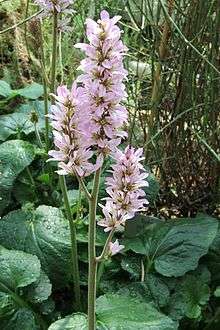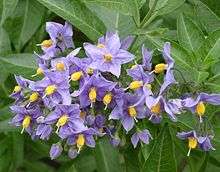James Anderson (botanical collector)
James Anderson (1797 – 22 April 1842) was a Scottish botanical collector who later became the superintendent of the Sydney Botanic Gardens.
Plant collecting
Between 1826 and 1830 Anderson sailed on HMS Adventure, collecting seeds and dried specimens.[2][3] This voyage, to the Straits of Magellan and the coast of South America, was captained by Phillip Parker King.[2] A collection of dried specimens was submitted to the British Museum after the voyage.[4]
He collected many South American species for the Clapton Nursery in London on behalf of Hugh Low and John Bain Mackay including the following:[2]
- Francoa appendiculata, Chiloé, Chile[5]
- Herbertia pulchella, Bay of Maldonado. Uruguay[6]
- Libertia formosa "from near the southern extremity of the continent of America" (introduced from seed)[7]
- Solanum crispum, Chiloé, Chile (introduced 1830)[8]
He also sent plant specimens to William Hooker at Glasgow University.[2]
 Francoa appendiculata
Francoa appendiculata- Libertia chinensis
 Solanum crispum
Solanum crispum
New South Wales
On 25 August 1832, Anderson arrived in Sydney on the ship Brothers which had set out from Plymouth on 4 May.[2][9] In 1835, he advertised seeds of 150 species of the "Flora of New South Wales" as well as 300 dried specimens for sale.[3] In the same year he was appointed to the position of assistant superintendent at Sydney Botanic Gardens. He became superintendent in 1838 and continued in this role until his death in 1842.[10]
Death
Anderson died in 1842 in his residence at the botanic gardens.[11] He was buried at Devonshire Street Cemetery, the inscription on his tombstone reading:
- Erected to the memory of the late James Anderson, Superintendent of the Botanic Gardens, Sydney, who died on the 22nd April, 1842. He was born at Boquhan, near Stirling, Scotland, in 1797, and travelled over a great part of Europe, Africa, and America, and along the coast of New Holland, collecting rare botanic specimens. He was of a most kindly disposition, and highly esteemed by all who knew him. This monument was subscribed for by a number of his friends in this colony to show their respect for his memory. [1]
In 1901 his remains were re-interred at the cemetery at La Perouse.[12]
Carex andersonii, a species that he collected at Port Famine on the Strait of Magellan, was named in his honour.[13][14]
References
- "The Devonshire-Street Cemetery". The Sydney Morning Herald. National Library of Australia. 7 February 1901. p. 3. Retrieved 22 May 2014.
- Desmond, Ray (1994). Anderson, James (1797-1842). Dictionary Of British And Irish Botanists And Horticulturalists including plant collectors, flower painters and garden designers. CRC Press. p. 15. ISBN 978-0-85066-843-8.
- "Advertising". The Sydney Herald. National Library of Australia. 19 March 1835. p. 3. Retrieved 23 May 2014.
- Godley, E.J. (November 1965). "Botany of the Southern Zone: Exploration to 1843". Tuatara : Journal of the Biological Society. 13 (3): 155–158.
- Curtis, William; Sims, John (1832). Curtis's Botanical Magazine Or Flower-garden Displayed. Edward Couchman. p. 4.
- Loudon, John Claudius (1828). The Gardener's Magazine and Register of Rural & Domestic Improvement. Longman, Rees, Orome, Brown and Green. pp. 199.
- The Edinburgh New Philosophical Journal. 1833. p. 384.
- Loudon, John Claudius (1838). Arboretum et fruticetum Britannicum; or, The trees and shrubs of Britain. Published by the author. pp. 1268.
- "SHIPPING INTELLIGENCE". The Sydney Herald. National Library of Australia. 27 August 1832. p. 2. Retrieved 23 May 2014.
- "Anderson, James (1797–1842)". Australian Plant Collectors and Illustrators 1780s-1980s. Council of Heads of Australian Herbaria. Retrieved 22 May 2014.
- "Family Notices". The Sydney Herald. National Library of Australia. 23 April 1842. p. 3. Retrieved 22 May 2014.
- Maiden, J.H. (23 May 1906). "Our Botanic Gardens". The Sydney Morning Herald. National Library of Australia. p. 4. Retrieved 22 May 2014.
- "Type of Carex andersonii Boott [family CYPERACEAE]". JSTOR Global Plants. Retrieved 29 May 2014.
- Campbell-Culver, Maggie (2014). The Origin Of Plants. Transworld. pp. 218–. ISBN 978-1-4735-0932-0.